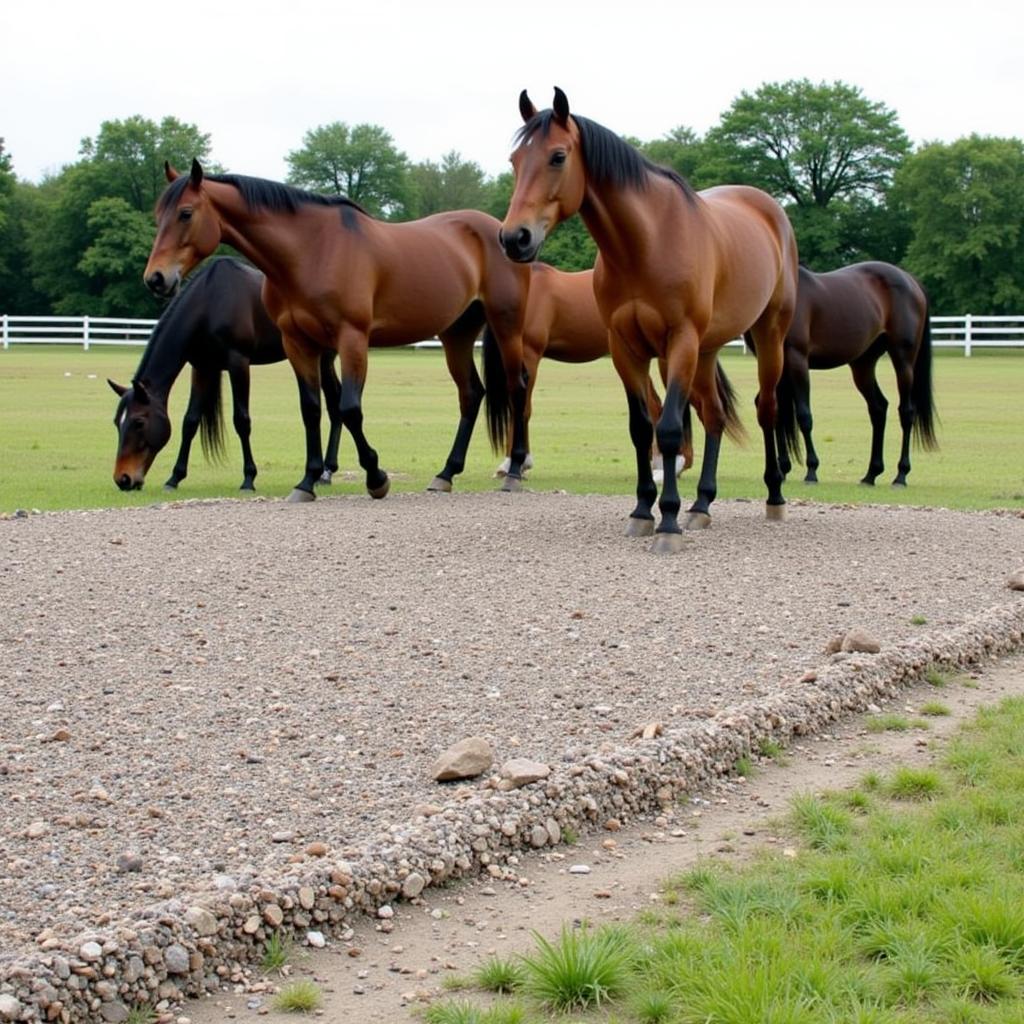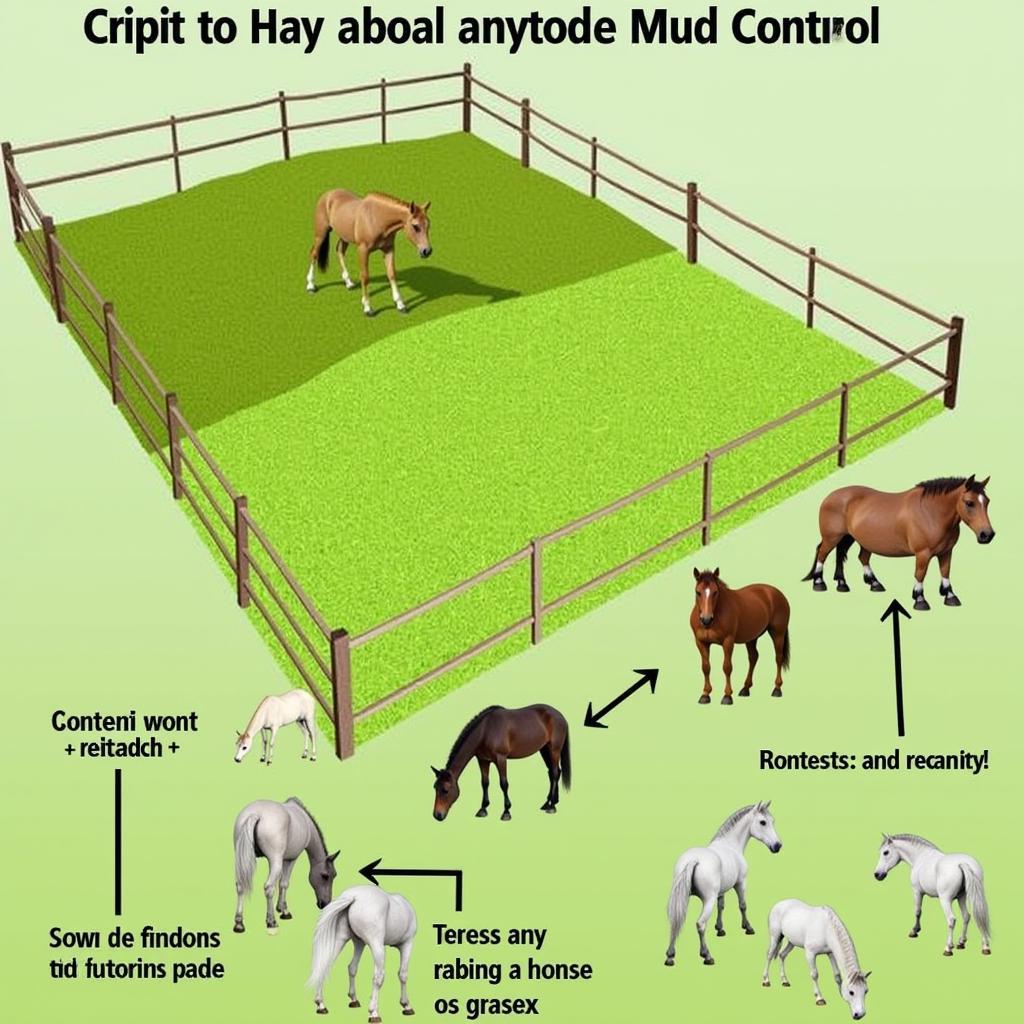Dealing with a muddy horse paddock is a common challenge for horse owners. Horse Paddock Mud Control is crucial not only for the aesthetics of your property but, more importantly, for the health and safety of your horses. Mud creates a breeding ground for bacteria and parasites, increasing the risk of infections like thrush and scratches. Plus, slippery footing can lead to serious injuries. Let’s explore practical and effective solutions for horse paddock mud control.
A well-drained paddock is the first line of defense against mud. This involves ensuring proper sloping of the land to direct water flow away from high-traffic areas. You might consider installing French drains or other drainage systems to divert excess water. Proper grading and drainage are essential foundations for effective horse paddock mud control. Check out our guide on horse stall runs for more information on drainage solutions that could be adapted for your paddock.
Understanding the Causes of Mud
Before implementing solutions, it’s vital to understand why your paddock gets muddy. Overgrazing, heavy rainfall, poor soil composition, and high traffic areas all contribute to mud problems. Identifying the primary causes will help you tailor your horse paddock mud control strategies for optimal results.
Identifying High Traffic Zones
Observe your horses’ movement patterns. Where do they congregate most often? Around gates, water troughs, and feeding areas are common hotspots for mud buildup. These high-traffic areas require specific attention in your mud control plan.
Practical Solutions for Horse Paddock Mud Control
Several effective methods can help you combat mud and maintain a healthy environment for your horses. Implementing a combination of these solutions often yields the best results.
Geotextiles and Gravel: A Powerful Duo
Geotextiles, permeable fabrics laid beneath gravel or other footing materials, provide a stable base that prevents the gravel from sinking into the mud. This creates a durable, all-weather surface that minimizes mud buildup.
 Geotextile and Gravel Paddock for Mud Control
Geotextile and Gravel Paddock for Mud Control
Proper Footing Materials: Choosing the Right One
Choosing appropriate footing materials is crucial. Options include sand, gravel, wood chips, and specialized footing mixes designed for equine use. The best choice depends on your budget, climate, and the specific needs of your horses.
Rotational Grazing: Giving Your Paddock a Break
Overgrazing compacts the soil and contributes significantly to mud problems. Implementing a rotational grazing system, dividing your paddock into smaller sections and rotating your horses between them, allows the grass to recover and prevents soil compaction. For ideas on creating separate areas for your horses, take a look at our resources on horse arena.
 Rotational Grazing Paddock Setup
Rotational Grazing Paddock Setup
Effective Drainage: Keeping Water Moving
As mentioned earlier, proper drainage is paramount. Ensure your paddock slopes gently away from high-traffic areas to prevent water accumulation. Consider installing French drains, swales, or other drainage systems to channel excess water away from your paddock. Thinking of improving your stable area too? Check out our recommendations on half chaps for riding horses.
Regular Maintenance: The Key to Long-Term Success
Maintaining your paddock is just as important as implementing initial mud control measures. Regularly remove manure with a paddock cleaner horse manure collector to minimize the breakdown of organic matter that contributes to mud. Additionally, address any drainage issues promptly to prevent them from escalating.
Conclusion: Achieving a Mud-Free Paddock
Effective horse paddock mud control is a continuous process that requires careful planning and consistent effort. By understanding the causes of mud and implementing a combination of practical solutions, you can create a healthier, safer, and more enjoyable environment for your horses, while also enhancing the appearance of your property. Remember, regular maintenance is crucial for long-term success in horse paddock mud control.
FAQs
-
What is the best material for horse paddock mud control? There’s no single “best” material. The ideal choice depends on factors like your climate, budget, and the type of soil in your paddock.
-
How can I improve drainage in my horse paddock? Ensure proper sloping and consider installing French drains or other drainage systems.
-
Is rotational grazing effective for mud control? Yes, it prevents overgrazing, allowing the grass to recover and preventing soil compaction.
-
How often should I remove manure from my paddock? Ideally, remove manure daily or at least several times a week.
-
Can geotextiles help with mud control? Absolutely, they provide a stable base that prevents gravel from sinking into the mud.
-
What are some other options for paddock footing? Sand, wood chips, and specialized footing mixes are other alternatives.
-
How can I prevent mud around my horse’s water trough? Create a gravel or paved area around the trough to minimize mud buildup.
Common Mud Control Scenarios and Solutions:
- Scenario: Mud concentrated around the gate area. Solution: Install a geotextile and gravel pathway leading to and from the gate.
- Scenario: Water pooling in certain areas of the paddock. Solution: Address drainage issues by adding a French drain or adjusting the slope of the paddock.
- Scenario: Overall muddy conditions throughout the paddock. Solution: Implement rotational grazing and consider adding footing materials like sand or wood chips.
Further Resources:
For more information related to horse care and property management, consider exploring other helpful resources on our website, such as those related to black horse run homes for sale.
Contact Us
For personalized advice on horse paddock mud control, feel free to contact us. Call us at 0772127271, email us at [email protected], or visit us at QGM2+WX2, Vị Trung, Vị Thuỷ, Hậu Giang, Việt Nam. Our customer service team is available 24/7 to assist you.